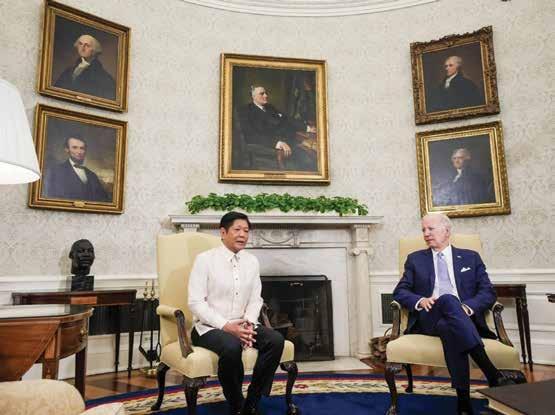
2 minute read
Marcos wants closer ties with US
by Kristina Maralit ManilaTimes.net
PRESIDENT Ferdinand Marcos Jr. sought a stronger alliance with the U.S. when he met President Joe Biden on Monday, May 1. Marcos pointed to escalating tensions in the Asia-Pacific and how vital U.S. assistance is on resolving the differences. He cited America’s role in maintaining peace, stability and development in the region.
Advertisement
“We need to find ways to strengthen our alliances and our partnership in the face of the new economy that we are facing post-pandemic,” he said in his opening statement, adding that current geopolitical issues put the Philippines in “arguably the most complicated geopolitical situation in the world right now.”
Because of this, it is “only natural” for the country to “look to its sole treaty partner in the world, to strengthen and to redefine the relationship” of the Philippines and the United States amid the volatile situation “around the South China Sea and the Asia-Pacific and Indo-Pacific region.”
“We have many things that are new that need to be assessed and again our role as partners in the world ... in our worldview of what we are hoping for the future of peace, not only in the Asia-Pacific and Indo-Pacific region but in the whole world,”
Marcos: Philippines-US ties rising above ‘turbulent times’
by alexis roMero Philstar.com
WASHINGTON — The longstanding relationship between the Philippines and the United States might have had “turbulent times,” but theirs is a bond that overcomes challenges because of a mutual understanding of their roles and values, President Marcos said.
Speaking at a dinner hosted by the Philippine embassy at Blair House last Tuesday, May 2, Marcos compared the treaty partners’ relationship to friendships tried by misunderstandings.
“You go through turbulent times when there are misunderstandings, when there are difficulties, when other forces prevail upon both sides of the partnership,” Marcos said.
TWO measures now making their way through the State Assembly aim to improve how California draws new district maps to ensure more participatory elections.
By some accounts, California’s independent redistricting commission (IRC) has set the gold standard for fair elections, wresting control of legislative mapmaking from the archetypal smoke-filled backroom dealmakers who’ve made an art of keeping power to themselves.
But recent examples point to the need for more and better reforms to ensure the state’s elections are open to all.
In Los Angeles, leaked reports of city councilmembers’ racist comments amid redistricting discussions last year exposed how the system still works there. In San Mateo County, the most recent round of redistricting found the Board of Supervisors voting to preserve the status quo even after hearing its own advisory committee suggest needed changes.
In the Central Valley, a steady, unrelenting campaign led by the county’s League of Women Voters and the Dolores Huerta Foundation pressured the Tulare County Board of Supervisors to finally draw fairer maps for the 65% Latino population







